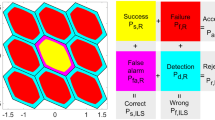Abstract
The combination of multiple global navigation satellite systems (GNSSs) is able to improve the accuracy and reliability, which is beneficial for navigation in safety–critical applications. Due to the relatively low accuracy of pseudorange observations, the single-epoch GNSS real-time kinematic (RTK) using phase observations can be utilized to achieve centimeter accuracy positioning instantaneously. Since the traditional ratio tests for ambiguity validation are not reliable in the presence of biases, it is therefore difficult for the single-epoch RTK to achieve high precision and high reliability, simultaneously. Instead of using an empirical constant detection threshold or a fixed failure/success rate requirement in the ratio tests for ambiguity validation, we propose an integrity monitoring-based ratio test (IM-RT). It uses the ambiguity protection level to control the false alarm and missed detection errors. The performance of the proposed method is tested by using simulated and real-world data. The simulation results show that the IM-RT can obtain an optimal balance between the false alarm and missed detection performance. The experiments from kinematic real-world data indicate that the IM-RT improves the positioning accuracy by over 10 cm and enhances the continuity by 11 %, when compared with the fixed detection threshold-based ratio test.









Similar content being viewed by others
Explore related subjects
Discover the latest articles, news and stories from top researchers in related subjects.References
DeGroot MH, Schervish MJ (2011) Probability and statistics, 4th edn. Addison-Wesley, New York
Euler H, Schaffrin B (1991) On a measure for the discernibility between different ambiguity solutions in the static-kinematic GPS-mode. In: IAG symposia no. 107, kinematic systems in geodesy, surveying, and remote sensing. Springer, New York, pp 285–295
Feng S, Ochieng W, Samson J et al (2012) Integrity monitoring for carrier phase ambiguities. J Navig 64(1):41–58
Ge M, Gendt G, Rothacter M, Shi C, Liu J (2008) Resolution of GPS carrier-phase ambiguities in precise point positioning (PPP) with daily observations. J Geod 82(7):389–399
Han S (1997) Quality-control issues relating to instantaneous ambiguity resolution for real-time GPS kinematic positioning. J Geod 71:351–361
Hwang P, Brown RG (2006) RAIM-FDE revisited: a new breakthrough in availability performance with NIORAIM (Novel Integrity Optimized RAIM). J Inst Navig 53(1):41–52
Khanafseh S, Pervan B (2010) A new approach for calculating position domain integrity risk for cycle resolution in carrier phase navigation systems. IEEE Trans Aero Electron Syst 46(1):296–307
Lee J, Pullen S, Enge P (2009) Sigma overbounding using a position domain method for the local area augmentation of GPS. IEEE Trans Aero Electron Syst 45(4):1262–1274
Leick A, Rapoport L, Tatarnikov D (2015) GPS satellite surveying, 4th edn. Wiley, New York
Li T, Wang J (2014) Analysis of the upper bounds for the integer ambiguity validation statistics. GPS Solut 18(1):85–94
Li Z, Yuan Y, Li H, Huo X (2012) Two-step method for the determination of the differential code biases of Compass satellites. J Geod 86(11):1059–1076
Li B, Verhagen S, Teunissen PJG (2014) Robustness of GNSS integer ambiguity resolution in the presence of atmospheric biases. GPS Solut 18(2):283–296
Parkins A (2011) Increasing GNSS RTK availability with a new single-epoch batch partial ambiguity resolution algorithm. GPS Solut 15(4):391–402
Teunissen PJG, Kleusberg A (1998) GPS for geodesy, 2nd edn. Springer, Berlin
Teunissen PJG, Verhagen S (2009) The GNSS ambiguity ratio-test revisited: a better way of using it. Surv Rev 41(312):138–151
Teunissen PJG, Joosten P, Tuberius CCJM (1999) Geometry-free ambiguity success rates in case of partial fixing. In: Proceedings of ION NTM-99, Institute of Navigation, San Diego, CA, January 25–25, pp 201–207
Tiberius C, Jonge P (1995) Fast positioning using the LAMBDA method. In: Proceedings of DSNS-95, Bergen, Norway, Bergen, Norway, Paper 30, p 8
Verhagen S, Teunissen PJG (2013) The ratio-test for future GNSS ambiguity resolution. GPS Solut 17(4):535–548
Verhagen S, Odijk D, Teunissen PJG, Huisman T (2010) Performance improvement with low-cost multi-GNSS receivers. In: Proceedings of 5th ESA workshop on satellite navigation technologies and European workshop on GNSS signals and signal processing (NAVITEC), pp 1–8
Wang J, Stewart MP, Tsakiri M (1998) A discrimination test procedure for ambiguity resolution on the fly. J Geod 72(11):644–653
Acknowledgments
The authors appreciate two anonymous reviewers for their editorial feedback and valuable suggestions. The authors are also very grateful to Dr. Sandra Verhagen from Delft University of Technology for the proofreading. This research was jointly funded by China Natural Science Foundation (Nos. 61304235, 41304034, 61273081), the Fundamental Research Funds for Central Universities (No. HEUCFD1431), the Key Laboratory for Urban Geomatics of National Administration of Surveying, Mapping, and Geoinformation (No. 20141205WY), and the Scientific Cooperation between China and the Netherlands programme ‘Compass, Galileo and GPS for improved ionosphere modeling.’
Author information
Authors and Affiliations
Corresponding authors
Rights and permissions
About this article
Cite this article
Li, L., Li, Z., Yuan, H. et al. Integrity monitoring-based ratio test for GNSS integer ambiguity validation. GPS Solut 20, 573–585 (2016). https://doi.org/10.1007/s10291-015-0468-y
Received:
Accepted:
Published:
Issue Date:
DOI: https://doi.org/10.1007/s10291-015-0468-y




